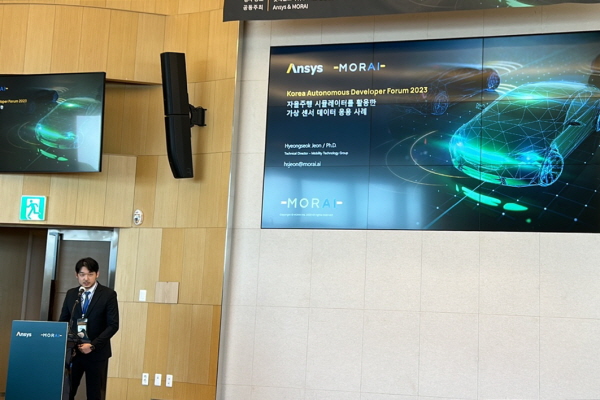전형석 모라이 이사는 모라이와 앤시스가 공동 개최한 ‘KADF 2023(Korea Autonomous Developer Forum)’에서 ‘자율주행 시뮬레이터를 활용한 가상 센서 데이터 응용 사례’에 대해 발표하며 자율주행 기술 평가 지표에 대해 논점을 던졌다.

▲전형석 모라이 이사가 발표하고 있다.
“고속도로·골목길 자율주행, 다른 지표로 평가받아야”
Style-transferred 딥러닝, 유저 맞춤식 가상 데이터 제공
전형석 모라이 이사가 어떤 차량이 자율주행이 잘하는 것인지에 대한 질문에 대한 답을 내릴 수 있는 평가 지표를 고민해 볼 필요가 있다고 전했다.
전형석 모라이 이사는 모라이와 앤시스가 공동 개최한 ‘KADF 2023(Korea Autonomous Developer Forum)’에서 ‘자율주행 시뮬레이터를 활용한 가상 센서 데이터 응용 사례’에 대해 발표하며 자율주행 기술 평가 지표에 대해 논점을 던졌다.
현재 자율주행에 대한 시스템을 평가에서는 주행거리와 디스인게이지먼트 발생 빈도를 지표로 삼고 있다.
전형석 이사는 위의 두 가지 지표에서 상위권을 차지한다고 해서 뛰어난 자율주행 기업으로 인정해야 하는가에 대한 의문을 던졌다.
고속도로에서만 테스트를 했을 경우, 골목길에서만 자율주행을 개발하는 경우 완전히 다른 지표로 평가해야 한다는 의견이다.
전 이사는 “자율주행 시스템에 대한 어떠한 평가 지표를 생각을 하는 것도 하나의 연구이며 고민해야 하는 부분”이라고 자신의 생각을 밝혔다.
그는 가상 데이터 셋의 평가 지표도 마찬가지라며 자율주행은 다양한 환경에서 주행하기 때문에 그 환경에 적합한 데이터를 필요로 한다.
이런 어려움을 타개하기 위한 한 가지 방법으로 모라이는 Style-transferred 딥너링 기법을 활용하여 유저가 원하는 환경에 맞춤식 가상 데이터를 제공한다.
전 이사는 “센서 이미지와 모라이와 앤시스의 솔루션에서 나온 데이터를 그대로 활용하는 것이 아닌 시뮬레이션에서 나온 가상 데이터에 실제 데이터에 대한 필터링 혹은 특성이 비슷하도록 Style Transfer한 데이터를 활용한 것이 훨씬 더 유용하다는 것을 내부적으로 확인했다”고 전했다.
그는 이어 현재 모든 차량이 자율주행인 환경으로 넘어가기 위한 과도기임과 동시에 제일 어려운 시기라며 자율주행차의 주변 차량의 운전자 특성이 매우 다양해 필요한 데이터 셋의 범위는 굉장히 넓어질 수밖에 없다고 설명했다.
전 이사는 “자율주행 기술을 개발하면서 이끌어 나가야 하는 위치에 있다”며 “다 함께 통일된 목표를 가지고 개발해 나가면 더 좋은 자율주행이 나오지 않을까라고 기대한다”고 말했다.
한편 전 이사는 현재 업체와 기관에서 배포하거나 구축하고 있는 데이터 셋이 정말 제네럴 하는 것인지 의문이라는 입장을 밝혔다.
차량을 개발하면서 부착하는 센서의 종류나 개수, 위치 등이 지금까지 통일된 것이 없고 각각의 회사마다 다른 컨피규레이션에서 취득된 데이터는 소용이 없다는 관점이다.
또한 평이한 상황의 데이터는 매우 쉽게 취득할 수 있지만 오히려 자율주행이 궁극적으로 해결해야 하는 엣지 케이스, 어려운 이벤트들에 대해서는 데이터들이 거의 발생하지 않는 단점이 있다.
도로에서 한 번이라도 문제가 발생한다면 자율주행 기술에 대한 신뢰도는 떨어질 수밖에 없다.
모라이는 이러한 상황을 해결하기 위해서는 시뮬레이터의 활용이 필요하기에 모라이와 Ansys(앤시스)는 협력을 통해 각 기업의 장점을 살려 데이터셋을 만드는 업무를 진행했으며 약 3,800만개의 샘플로 대규모 데이터셋을 구축을 했다고 전했다.
